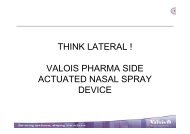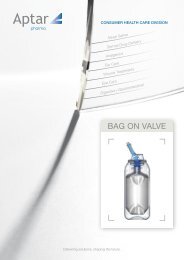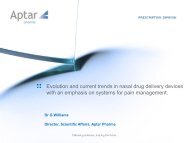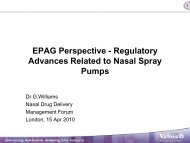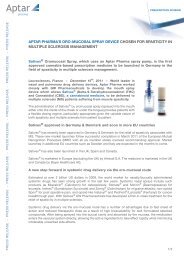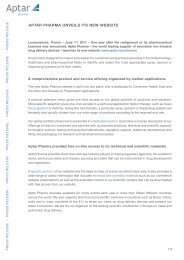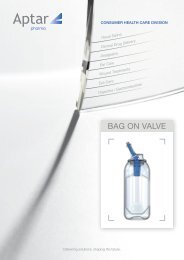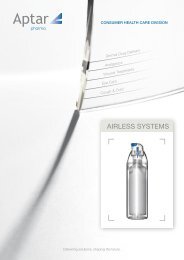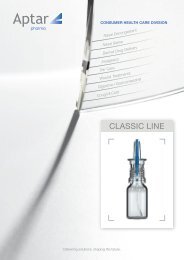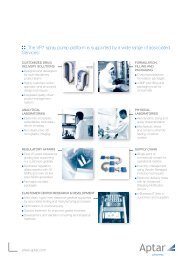Multi-Dose Container for Nasal and Ophthalmic Drugs: A ... - Aptar
Multi-Dose Container for Nasal and Ophthalmic Drugs: A ... - Aptar
Multi-Dose Container for Nasal and Ophthalmic Drugs: A ... - Aptar
You also want an ePaper? Increase the reach of your titles
YUMPU automatically turns print PDFs into web optimized ePapers that Google loves.
<strong>Multi</strong>-<strong>Dose</strong> <strong>Container</strong> <strong>for</strong> <strong>Nasal</strong> <strong>and</strong> <strong>Ophthalmic</strong> <strong>Drugs</strong>: A Preservative Free Future 521<br />
Picture 5. On the left: Rendered picture of the <strong>Ophthalmic</strong> Squeeze Dispenser (OSD)<br />
showing the tip seal <strong>and</strong> filter <strong>for</strong> the venting air in blue. Right: the complete system after<br />
filling <strong>and</strong> with removed protection cap.<br />
A break through approach may be the <strong>Ophthalmic</strong> Squeeze Dispenser (OSD) which uses the<br />
mechanical tip-seal technology combined with sterile filtration of the venting air known<br />
from preservative free nasal spray pumps. The OSD is simply actuated by squeezing a<br />
LDPE (low density polyethylene) bottle <strong>and</strong> will deliver a drop in the range of 35 µl. The<br />
device can easily be adapted <strong>for</strong> a certain range of viscosity to keep <strong>for</strong>ces within a rational<br />
limit <strong>and</strong> to deliver a consistent drop. Not only is the dropper highly sophisticated but the<br />
bottle too. The thickness of the bottle wall must be a compromise between minimizing water<br />
vapor loss <strong>and</strong> providing acceptable actuation <strong>for</strong>ces. Of course the fit between bottle <strong>and</strong><br />
dropper must be perfect to avoid contamination via this way. As some ophthalmic<br />
<strong>for</strong>mulations have compatibility issues with metal, the OSD features a metal-free fluid path.<br />
6. Microbial device integrity tests<br />
To introduce a preservative-free multi-dose device successfully on the market, the microbial<br />
integrity must be clearly demonstrated to customers <strong>and</strong> authorities. Although there are<br />
guidelines in place <strong>for</strong> preserved multi-dose <strong>and</strong> preservative-free single dose containers,<br />
there is no guideline on microbial testing of preservative-free multi-dose devices. So the<br />
industry has to develop convincing test methods on their own. A well known procedure is<br />
the so called Wiedemann test, which was developed to characterize the 3K/Comod-system<br />
(Bagel <strong>and</strong> Wiedemann, 2004). This test <strong>for</strong> nasal sprays focuses on the microbial load of the<br />
next sprayed dose <strong>and</strong> was developed according to the needs of the system which releases<br />
silver ions into the <strong>for</strong>mulation. The acceptance criteria are less than 100 CfU/ml delivered<br />
dose (according the EU Pharmacopeia) <strong>and</strong> no contamination of the bottle content. Similar<br />
tests were developed using a very agile germ (Pseudomonas aeruginosa) <strong>for</strong> the tip seal test<br />
<strong>and</strong> the tiny <strong>and</strong> robust spores from Baccilus subtilis <strong>for</strong> the whole package integrity test.<br />
These tests may be used <strong>for</strong> the characterization of preservative-free multi-dose nasal spray



